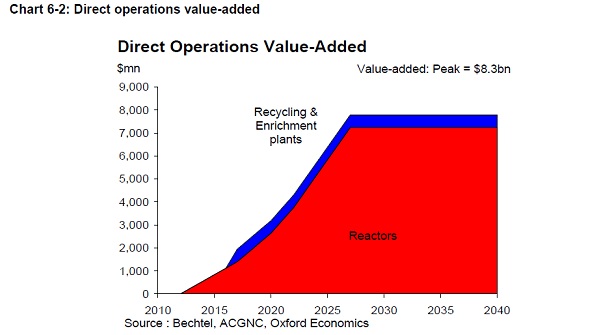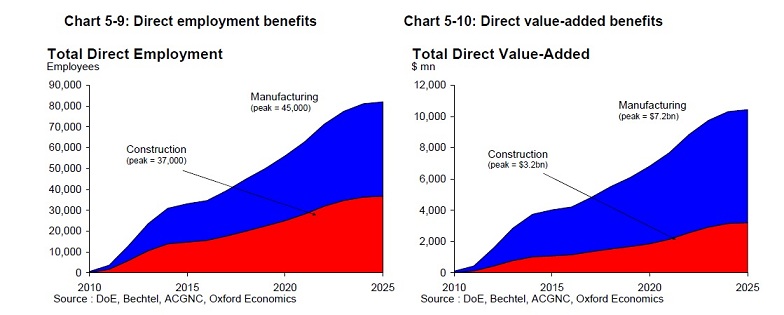- The Vitruvian Plant: Powering the Future #10-2284
-
Background
History of Nuclear Energy Nuclear Agencies and Regulations Nuclear Power in the Public Eye Economics of Nuclear Energy Radioactivity Basics Nuclear Reactor Basics Current Reactor Designs Processing Radioactive Materials Remote Handling Uses of Radiation Archimedes Filter Technology New Generation Reactors
- Components
- Project
Component Three
Provide a forecast of what the workforce demand would be over a five-year period to produce and market your team's technical application or process. Include the impact such production would have on the marketplace.
The Palo Verde Nuclear Generating Station is a unique nuclear reactor site
in Arizona and is only 45 miles from Phoenix. Maricopa County, the county that the
station is in, has a population of 3.3 million and covers 9,203 square miles. The
Palo Verde Station has 3 large pressurized water reactors and is considered as the
largest nuclear power plant and the top power producer in the United States in 2004.
Including the costs to do maintenance, operations, and fuel costs, the average production cost of Palo Verde is 1.33 cents per Kilowatt-Hour. This is significantly more efficient compared to the average production of coal, which is 2.26 cents per Kilowatt-Hour, or natural gas, which is 4.54 cents per Kilowatt-Hour, because Palo Verde imports their nuclear fuel from other countries like Canada, which greatly increases the fuel costs. Not only is Palo Verde cheap to maintain, it also generates a large amount of electricity in the Arizona/New Mexico/Nevada Power Area. In 2002, Palo Verde generated more than 30.9 million Megawatt-Hours of electricity, which is only surpassed by its more prevalent competitor, coal, which produced 68.8 million Megawatt-Hours of electricity.
One of the main improvements to our plant compared to other existing sites is that we do not need to transport our nuclear waste for either recycling or reprocessing. This is because of the Archimedes filter plant, which separates the material through a plasmification process on-site. The following graph that was created by Oxford Economics predicts that there will be innovations similar to our own because even though there is a large increase in the operational cost of reactors, the operational cost for recycling and enrichment actually decreases slightly over time. The reason that the operational cost decreases over time is because the innovations cause an increase in the overall productivity of the cycle as a whole.
The following charts depict the projected increase of employment in both the construction and the operation of nuclear reactors as well as the economic implications of these increasing employments. The graph on the left shows that manufacturing jobs will be more expansive and more prominent in the nuclear field compared to construction jobs. Since a manufacturing job requires more training and higher wages, the direct value-added is significantly higher for manufacturing than construction. Our employment would follow a similar trend as the two graphs with more dramatic increases because of the integration of the Archimedes Filter Plant and waste storage in the same compound.
One of the problems with the nuclear field today is that the cost of the fuel is slowly but surely increasing. In a study done by the Energy Information Administration, the price of fuel from 1994-2009 has increased from $10.40 per pound to $45.86. Our plant will combat the increasing prices of uranium because the traveling wave reactor only needs a small amount of enriched uranium and we can reuse our own waste after it has been separated in the Archimedes Facility. Another benefit of the Archimedes Facility is that it can create fuel, such as Plutonium-239 for breeder reactors or enriched uranium for a boiling water reactor, to be exported by our plant to other reactor sites.
Including the costs to do maintenance, operations, and fuel costs, the average production cost of Palo Verde is 1.33 cents per Kilowatt-Hour. This is significantly more efficient compared to the average production of coal, which is 2.26 cents per Kilowatt-Hour, or natural gas, which is 4.54 cents per Kilowatt-Hour, because Palo Verde imports their nuclear fuel from other countries like Canada, which greatly increases the fuel costs. Not only is Palo Verde cheap to maintain, it also generates a large amount of electricity in the Arizona/New Mexico/Nevada Power Area. In 2002, Palo Verde generated more than 30.9 million Megawatt-Hours of electricity, which is only surpassed by its more prevalent competitor, coal, which produced 68.8 million Megawatt-Hours of electricity.
One of the main improvements to our plant compared to other existing sites is that we do not need to transport our nuclear waste for either recycling or reprocessing. This is because of the Archimedes filter plant, which separates the material through a plasmification process on-site. The following graph that was created by Oxford Economics predicts that there will be innovations similar to our own because even though there is a large increase in the operational cost of reactors, the operational cost for recycling and enrichment actually decreases slightly over time. The reason that the operational cost decreases over time is because the innovations cause an increase in the overall productivity of the cycle as a whole.
The following charts depict the projected increase of employment in both the construction and the operation of nuclear reactors as well as the economic implications of these increasing employments. The graph on the left shows that manufacturing jobs will be more expansive and more prominent in the nuclear field compared to construction jobs. Since a manufacturing job requires more training and higher wages, the direct value-added is significantly higher for manufacturing than construction. Our employment would follow a similar trend as the two graphs with more dramatic increases because of the integration of the Archimedes Filter Plant and waste storage in the same compound.
One of the problems with the nuclear field today is that the cost of the fuel is slowly but surely increasing. In a study done by the Energy Information Administration, the price of fuel from 1994-2009 has increased from $10.40 per pound to $45.86. Our plant will combat the increasing prices of uranium because the traveling wave reactor only needs a small amount of enriched uranium and we can reuse our own waste after it has been separated in the Archimedes Facility. Another benefit of the Archimedes Facility is that it can create fuel, such as Plutonium-239 for breeder reactors or enriched uranium for a boiling water reactor, to be exported by our plant to other reactor sites.
In an email dated February 16, 2011, our adviser Mr. Michael Friend stated:
The advantage to having a plant on-site to complete manufacturing and fueling of the fast reactors would be:
- The cost savings offered by shared remote handling systems.
- The ability to move waste and fuel products in a sealed system all the way from initial waste, through the Archimedes separation, to useful fuel loaded into a new reactor.
- An option to place the fast reactors in a farm on-site to feed power to the grid, or ship them out to customers, or both. Selling small reactors to schools, hospitals, etc. as you mentioned, would provide revenue support for operation of the AFP and fast reactor manufacturing.
Give two examples of undergraduate or graduate degree programs in science or engineering
that directly relate to your team's NCT technical application. For each program,
be sure to include the following:
 the URL address of the institution,
the URL address of the institution,
 the department (for example, chemical engineering, electronic
engineering) where the program is offered, and
the department (for example, chemical engineering, electronic
engineering) where the program is offered, and
 a brief description of the program of study.
a brief description of the program of study.
|
The University of Michigan has one of the top engineering programs in the country. The quality and diversity of University of Michigans engineering department allows students to take classes in many other fields of study while they major in nuclear engineering and radiological sciences. University of Michigan offers many courses on plasma technology, robotics, and mechanical engineering which directly relate to our product. A student who has received an undergraduate degree for nuclear engineering and radiological science would be well prepared to move into our graduate program and work with our product. |
|
The California Institute of Technology is renown for its engineering department which provides an atmosphere that inspires their students to address the technological issues of today. The California Institute of Technology prepares students for professional life in increasingly advancing interdisciplinary technology, using classes in robotics, mechanical engineering, and energy. |
Develop an idea for a new science and/or engineering degree program that might emerge given the advancements in scientific knowledge that the team has identified. Provide a title and 100-word description of this new degree program.
Our graduate program, Nuclear Engineering Waste Conservation Sciences (NEWCS),
will give students the knowledge and experience to design and operate equipment
as well as thoroughly understand the systems involved in nuclear reprocessing. They
will focus on the maintenance of facilities and the application of modern theories
in order to increase the efficiency and safety of nuclear fission reactors. Applicants
to the program should have a concentration in Engineering, or Nuclear Physics.
| Year One | |
| Nuclear Physics Bachelors | Engineering Bachelors |
|
Advanced Topics in Thermodynamics Fundamentals to Circuit Design Fundamentals in Structures and Solid Mechanics Advanced Topics in Chemistry and Material Science |
Introduction to Nuclear Instrumentation Fluid Dynamics in High Energy Fields Fundamentals of Nuclear Chemistry Advanced Studies in Transmutation of Materials |
| *Electives | |
|
*Introduction to Breeder Reactors *Radioactive Waste Remediation and Disposal Strategies |
*Ethics and Public Relations of Nuclear Power *Energy Conversion Systems |
| Year Two | |
| Courses | Internship |
|
Introduction to Remote Handling Nuclear Reactor Theory Nuclear Systems Design |
Students must complete a semester internship at a nuclear facility, focusing on the construction of reactors and the processing/rotation of fuel. Students must also provide a thesis of an innovation to the nuclear cycle to complete their graduate program requirements. |
California Institute of Technology
http://www.caltech.edu/
Economic Benefits of Palo Verde Nuclear Generating Station: An Economic Impact Study by the Nuclear Energy Institute
http://www.nei.org/resourcesandstats/documentlibrary/reliableandaffordableenergy/economicbenefitsstudies/paloverde
Economic, Employment and Environmental Benefits of Renewed U.S. Investment in Nuclear Energy
http://nuclearcompetitiveness.org/images/Oxford_State_Benefits_2008.pdf
Michigan Engineering: Letter From the Chair
http://www-ners.engin.umich.edu/
Uranium Purchased by Owners and Operators of U.S. Civilian Nuclear Power Reactors
http://www.eia.doe.gov/cneaf/nuclear/umar/summarytable1.html



